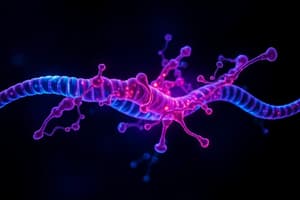Podcast
Questions and Answers
Match the following epigenetic mechanisms with their descriptions:
Match the following epigenetic mechanisms with their descriptions:
Histone modifications = Alteration of DNA and/or associated proteins without nucleotide sequence variance DNA methylation = Prokaryotic mechanism for regulating gene expression Chromatin-associated complexes = Regulation of gene expression to generate various cell types during development Noncoding RNAs = Regulation of gene expression in response to external stimuli
Match the following terms with their definitions related to chromatin structure:
Match the following terms with their definitions related to chromatin structure:
Chromatin = A highly compact form of DNA that can fit in the cell nucleus Nucleosomes = A mixture of DNA and proteins that form the chromosomes Histones = Proteins that package the massive amount of DNA in a genome Chromatin-associated complexes = Proteins that regulate gene expression during development
Match the following epigenetic factors with their roles in gene regulation:
Match the following epigenetic factors with their roles in gene regulation:
Histone modifications = Regulation of gene expression in response to external stimuli DNA methylation = Prokaryotic mechanism for silencing gene expression RNA splicing factors = Post-translational modification of histone proteins Noncoding RNAs = Regulation of gene expression during development
Match the following terms with their descriptions related to histone modifications:
Match the following terms with their descriptions related to histone modifications:
Match the following epigenetic mechanisms with their effects on gene expression:
Match the following epigenetic mechanisms with their effects on gene expression:
Match the following components with their roles in chromatin structure:
Match the following components with their roles in chromatin structure:
Match the following histone modifications with their effects on chromatin structure:
Match the following histone modifications with their effects on chromatin structure:
Match the following epigenetic mechanisms with their effects on gene expression:
Match the following epigenetic mechanisms with their effects on gene expression:
Match the following post-translational modifications with their effects on histone tails:
Match the following post-translational modifications with their effects on histone tails:
Match the following mechanisms with their roles in regulating gene expression:
Match the following mechanisms with their roles in regulating gene expression:
Match the following histone modifications with their respective enzymes:
Match the following histone modifications with their respective enzymes:
Match the following epigenetic modifications with their effects on gene expression:
Match the following epigenetic modifications with their effects on gene expression:
Match the following epigenetic marks with their effects on chromatin structure:
Match the following epigenetic marks with their effects on chromatin structure:
Match the following mechanisms with their roles in chromatin remodeling:
Match the following mechanisms with their roles in chromatin remodeling:
Match the following histone modifications with their locations on histone proteins:
Match the following histone modifications with their locations on histone proteins:
Match the following post-translational modifications with their effects on chromatin structure:
Match the following post-translational modifications with their effects on chromatin structure:
Match the following epigenetic modifications with their regulation of chromatin structure:
Match the following epigenetic modifications with their regulation of chromatin structure:
Match the following histone modifications with their effects on histone protein interactions:
Match the following histone modifications with their effects on histone protein interactions:
Flashcards are hidden until you start studying
Study Notes
Chromatin and Epigenetics
- Chromatin refers to a mixture of DNA and proteins that form the chromosomes found in the cells of humans and other higher organisms.
- Histones package the massive amount of DNA in a genome into a highly compact form that can fit in the cell nucleus.
- Nucleosomes are composed of histones (beads) and DNA (string).
Epigenetic Factors
- Epigenetics is the study of stable alterations in gene expression potentials that arise during development and cell proliferation, or alterations in DNA function without alteration in DNA sequence.
- Epigenetic mechanisms regulate expression of the genome to generate various cell types during development or orchestrate cellular responses to external stimuli.
- Epigenetic factors include histone modifications, DNA methylation, chromatin-associated complexes, noncoding RNAs, and RNA splicing factors.
Histone Modifications
- Histones are primary protein components of eukaryotic chromatin and play a role in gene regulation.
- Histone modifications impact chromatin structure and gene expression by making the DNA more or less accessible to transcription.
- Histone modifications include histone acetylation/deacetylation, histone phosphorylation, histone methylation, and histone demethylation.
Histone Acetylation and Deacetylation
- Histone acetylation adds an acetyl group to histone proteins, making the DNA more accessible to transcription (euchromatin).
- Histone deacetylation removes an acetyl group, making the DNA less accessible to transcription (heterochromatin).
Histone Phosphorylation
- Histone phosphorylation involves the addition of a phosphoryl group to histone tails, which can play a part in chromatin remodeling and cellular response to DNA damage.
DNA Methylation
- DNA methylation is a heritable epigenetic mark involving the covalent transfer of a methyl group to the C-5 position of the cytosine ring of DNA by DNA methyltransferases (DNMTs).
- DNA methylation regulates gene expression by recruiting proteins involved in gene repression or by inhibiting the binding of transcription factor(s) to DNA.
Non-Coding RNA
- Non-coding RNA regulates gene expression at multiple levels by interacting with DNA, RNA, and proteins.
- Non-coding RNA can modulate chromatin structure and function, transcription of neighboring and distant genes, and affect RNA splicing, stability, and translation.
Histone Methylation and Demethylation
- Histone methylation involves the transfer of methyl groups to histone proteins via histone methyltransferases (HMTs).
- Histone demethylation is the removal of methyl groups from histone tails catalyzed by histone demethylases (HDMs).
- Histone methylation and demethylation have the power to reduce or bolster gene expression, especially as a result of altering chromatin structure.
Studying That Suits You
Use AI to generate personalized quizzes and flashcards to suit your learning preferences.



